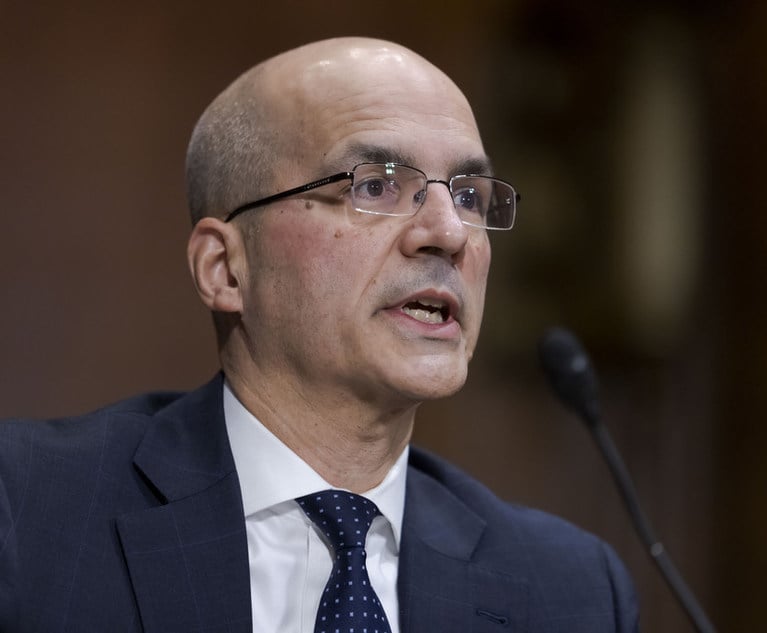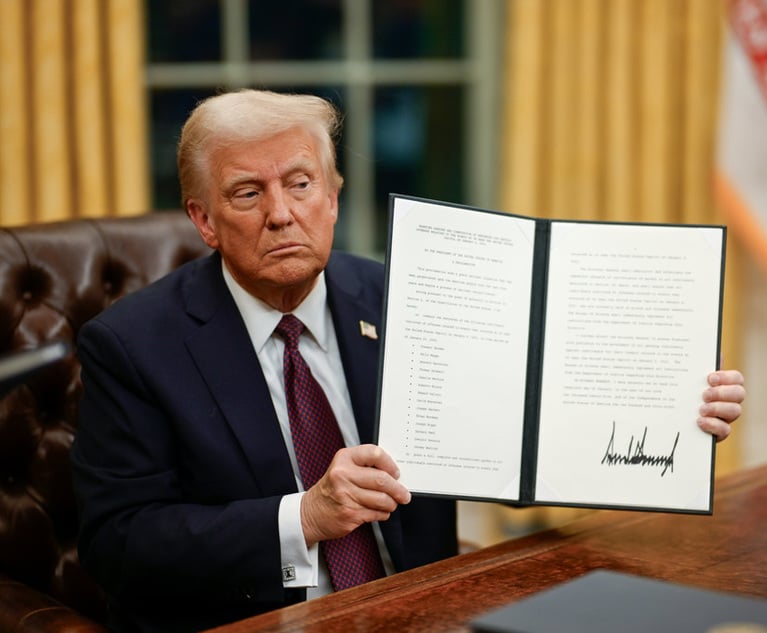Family Feud: Clarifying the Existence of a Confidential or Fiduciary Relationship Among Family Members
Breach of fiduciary duty and constructive trust claims are being asserted in the context of familial business relationships with greater frequency. In that context, the requirement of the existence of a confidential or fiduciary relationship becomes the key element and the primary focus for analysis with respect to the ultimate merits of the constructive trust and breach of fiduciary causes of action.
August 28, 2019 at 11:00 AM
8 minute read
 Efrem Z. Fischer
Efrem Z. Fischer
My father once cautioned me, "When it comes to doing business with family, blood isn't always thicker than water."
Often, because familial working relationships and agreements over real property lack a formal written contract governing their terms, upon the inevitable breakdown, the impending litigation is predicated on a panoply of non-breach of contract causes of action such as constructive trust and breach of fiduciary duty. At the root of such claims is the burden to establish the existence of a confidential or fiduciary relationship.
Put another way, breach of fiduciary duty and constructive trust claims are being asserted in the context of familial business relationships with greater frequency. In that context, the requirement of the existence of a confidential or fiduciary relationship becomes the key element and the primary focus for analysis with respect to the ultimate merits of the constructive trust and breach of fiduciary causes of action.
The Burden of Proof
Under New York's Statute of Frauds, "an oral agreement to convey an estate or interest in real property, other than a lease for a term not exceeding one year, is nugatory and unenforceable and a party to the agreement may legally and rightfully refuse to recognize or perform it." Messner Vetere Berger McNamee Schmetterer Euro RSCG v. Aegis Group PLC, 93 N.Y.2d 229, 235 (1999) (internal citations and quotations omitted); G.O.L. 5-703. Significantly, under New York law, when the alleged agreement at issue is the conveyance of real property, for which there is no writing, alternative causes of action based upon the alleged agreement are also barred by reason of the Statute of Frauds defense.
"Whatever the form of the action at law may be, if the proof of a promise or contract, void by the Statute of Frauds is essential to maintain it, there can be no recovery." Lilling v. David Slauenwhite, 145 A.D.2d 471 (2d Dep't 1988), citing Dung v. Parker, 52 N.Y. 494 (1873). Thus, New York courts have consistently held that claims for damages that arise from contracts rendered unenforceable by the Statute of Frauds may not be maintained. Priolo Communications v. MCI Telecommunications Corporation, 248 A.D.2d 453 (2d Dep't 1998); Sater v. Wyckoff Heights Hospital, 228 A.D.2d 427 (2d Dep't 1996); Komolov v. Segal, 117 A.D.3d 557 (1st Dep't 2014); Kocourek v. Booz Allen Hamilton Inc., 71 A.D.3d 511, 512, 900 N.Y.S.2d 1 (1st Dep't 2010); Nemelka v. Questor Mgt. Co., LLC, 40 A.D.3d 505, 506, 836 N.Y.S.2d 598 (1st Dep't 2007); Andrews v. Cerberus Partners, 271 A.D.2d 348, 707 N.Y.S.2d 85 (1st Dep't 2000). Simply put, New York courts may dismiss causes of action which are merely duplicative of an unenforceable breach of contract claim. As such, plaintiffs, in this predicament, have attempted to seek redress through the equitable relief afforded by the causes of action for constructive trust and/or breach of fiduciary duties.
Under New York law, to establish a constructive trust, a plaintiff must come forward with evidence of: (1) a confidential or fiduciary relationship, (2) a promise, (3) a transfer in reliance on that promise, and (4) unjust enrichment. Sharp v. Kosmalski, 40 N.Y.2d 119 (1976); Pereira v. Glicker, 61 A.D.3d 948 (2d Dep't 2009); Maiorino v. Galindo, 65 A.D.3d 525, 526 (2d Dep't 2009); Nastasi v. Nastasi, 26 A.D.3d 32 (2d Dep't 2005). Also, under New York law, the elements of a cause of action for breach of fiduciary duty are (1) the existence of a fiduciary relationship, (2) misconduct by the defendant, and (3) damages directly caused by the defendant's misconduct." Palmetto Partners, L.P. v. AJW Qualified Partners, 83 A.D.3d 804, 807 (2d Dep't 2011) (internal citation omitted). Common to both causes of action is the burden to establish the existence of a confidential or fiduciary relationship.
Generally, parties have a fiduciary relationship "when one of them is under a duty to act for or to give advice for the benefit of another upon matters within the scope of the relation." EBC I v. Goldman Sachs & Co., 5 N.Y.3d 11, 19 (2005), quoting Restatement (Second) of Torts §874, Comment A; Oddo Asset Mgt. v. Barclays Bank PLC, 19 N.Y.3d 584, 592-93 (2012) (internal quotations omitted). As such, alleging that the existence of a fiduciary relationship is inherently present merely because the parties are related may prove fatal to the cause of action. In other words, the mere existence of a familial relationship, standing alone, will not constitute a confidential or fiduciary relationship. Courts require specific allegations, and ultimately evidence, that the plaintiff placed particular trust or confidence in the defendant, or that he or she relied on defendant's alleged superior expertise or knowledge. The entire cause of action cannot be solely based upon the family relationship between the parties, because, under the applicable law, a mere familial relationship is legally insufficient. E.g., Chasanoff v. Perlberg, 19 A.D.3d 635 (2d Dep't 2005); Kallman v. Pinecrest Modular Homes, 81 A.D.3d 692 (2d Dep't 2011); Soley v. Wasserman, No. 08 Civ. 9262, 2011 U.S. Dist. LEXIS 109470, at **31-32 (S.D.N.Y.), adopted in part, 823 F. Supp. 2d 221 (S.D.N.Y 2011). Accordingly, if a plaintiff cannot provide that any confidential or fiduciary relationship exists between the parties, s/he cannot satisfy this element.
'Perez v. Perez'
State Supreme Court Justice Loren Baily-Schiffman recently addressed this issue in Perez v. Perez. No. 516348/17, 2018 N.Y. Misc. LEXIS 6236 (N.Y. Sup. Dec. 12, 2018). The decision is notable for the willingness of the court to dismiss such arguably factual causes of action without the benefit of full discovery. In Perez, the defendant was the title owner of the subject property located in Brooklyn from 1976 to 2016 when he sold the property to a third party. Plaintiffs were the son and daughter of defendant's deceased brother. As heirs of the deceased brother, plaintiffs asserted that they were entitled to the property because their father allegedly managed and maintained the property, and that defendant held the property for the benefit of plaintiff and his heirs. The defendant asserted that he alone had purchased the property, and had permitted his deceased brother to manage the property and retain the net profits from the rental income in lieu of a management fee. After his brother's death in 2003, defendant had permitted plaintiffs to manage the property and to retain the net profits as their father had. Although the plaintiffs alleged that the defendant held the property for the benefit of plaintiff and his heirs, there was no such written contract between the parties. Seeking ownership and control of the property, plaintiffs asserted causes of action for, inter alia, constructive trust and breach of fiduciary duty.
Justice Baily-Schiffman noted that the complaint only asserted that the defendant and the plaintiffs' deceased father were brothers. Relying on then-Southern District of New York Chief Magistrate Judge Frank Maas' decision in Soley, the court held that a family relationship alone does not establish the first element of a constructive trust: that there be a confidential or fiduciary relationship. While a fiduciary relationship may exist when family members are involved in a co-owned business, "in the case at bar nowhere is it alleged that Defendant and his brother … were involved in a co-owned family business." Perez, 2018 N.Y. Misc. LEXIS 6236 at *4. The court further stated that plaintiffs' reference to the relationship as "business-like" does not create a question of fact as to whether there was a fiduciary relationship between the brothers.
Conclusion
As Justice Baily-Schiffman noted, a fiduciary relationship may be found among family members who are also partners or co-owners in a business. Perez, 2018 N.Y. Misc. LEXIS 6236 at **3-4; see also Birnbaum v. Birnbaum, 73 N.Y.2d 461 (1989); Venizelos v. Oceania Maritime Agency, 268 A.D.2d 291 (1st Dep't 2000); Braddock v. Braddock, 60 A.D.3d 84 (1st Dep't 2009). However, allegations or evidence of a mere familial relationship between the parties, even coupled with one party's management of the subject real property, cannot constitute a confidential or fiduciary relationship. At a minimum, to sustain such causes of action, and to establish the existence of a fiduciary relationship in particular, the plaintiff must allege that he co-owned or was a partner in the family business, that he placed particular trust or confidence in the defendant, or that he relied on the defendant's alleged superior expertise or knowledge relative to the disputed factual issues. Otherwise, the family member without a contract is left without a remedy.
Efrem Z. Fischer is a senior attorney with the Klein Law Group CRE, PLLC, a boutique law firm specializing in real estate law and litigation, and counsel for the defendant in the 'Perez' action discussed herein.
This content has been archived. It is available through our partners, LexisNexis® and Bloomberg Law.
To view this content, please continue to their sites.
Not a Lexis Subscriber?
Subscribe Now
Not a Bloomberg Law Subscriber?
Subscribe Now
NOT FOR REPRINT
© 2025 ALM Global, LLC, All Rights Reserved. Request academic re-use from www.copyright.com. All other uses, submit a request to [email protected]. For more information visit Asset & Logo Licensing.
You Might Like
View All
'A Shock to the System’: Some Government Attorneys Are Forced Out, While Others Weigh Job Options
7 minute read
'Serious Legal Errors'?: Rival League May Appeal Following Dismissal of Soccer Antitrust Case
6 minute read
How Some Elite Law Firms Are Growing Equity Partner Ranks Faster Than Others
4 minute read
Trending Stories
- 1States Accuse Trump of Thwarting Court's Funding Restoration Order
- 2Microsoft Becomes Latest Tech Company to Face Claims of Stealing Marketing Commissions From Influencers
- 3Coral Gables Attorney Busted for Stalking Lawyer
- 4Trump's DOJ Delays Releasing Jan. 6 FBI Agents List Under Consent Order
- 5Securities Report Says That 2024 Settlements Passed a Total of $5.2B
Who Got The Work
J. Brugh Lower of Gibbons has entered an appearance for industrial equipment supplier Devco Corporation in a pending trademark infringement lawsuit. The suit, accusing the defendant of selling knock-off Graco products, was filed Dec. 18 in New Jersey District Court by Rivkin Radler on behalf of Graco Inc. and Graco Minnesota. The case, assigned to U.S. District Judge Zahid N. Quraishi, is 3:24-cv-11294, Graco Inc. et al v. Devco Corporation.
Who Got The Work
Rebecca Maller-Stein and Kent A. Yalowitz of Arnold & Porter Kaye Scholer have entered their appearances for Hanaco Venture Capital and its executives, Lior Prosor and David Frankel, in a pending securities lawsuit. The action, filed on Dec. 24 in New York Southern District Court by Zell, Aron & Co. on behalf of Goldeneye Advisors, accuses the defendants of negligently and fraudulently managing the plaintiff's $1 million investment. The case, assigned to U.S. District Judge Vernon S. Broderick, is 1:24-cv-09918, Goldeneye Advisors, LLC v. Hanaco Venture Capital, Ltd. et al.
Who Got The Work
Attorneys from A&O Shearman has stepped in as defense counsel for Toronto-Dominion Bank and other defendants in a pending securities class action. The suit, filed Dec. 11 in New York Southern District Court by Bleichmar Fonti & Auld, accuses the defendants of concealing the bank's 'pervasive' deficiencies in regards to its compliance with the Bank Secrecy Act and the quality of its anti-money laundering controls. The case, assigned to U.S. District Judge Arun Subramanian, is 1:24-cv-09445, Gonzalez v. The Toronto-Dominion Bank et al.
Who Got The Work
Crown Castle International, a Pennsylvania company providing shared communications infrastructure, has turned to Luke D. Wolf of Gordon Rees Scully Mansukhani to fend off a pending breach-of-contract lawsuit. The court action, filed Nov. 25 in Michigan Eastern District Court by Hooper Hathaway PC on behalf of The Town Residences LLC, accuses Crown Castle of failing to transfer approximately $30,000 in utility payments from T-Mobile in breach of a roof-top lease and assignment agreement. The case, assigned to U.S. District Judge Susan K. Declercq, is 2:24-cv-13131, The Town Residences LLC v. T-Mobile US, Inc. et al.
Who Got The Work
Wilfred P. Coronato and Daniel M. Schwartz of McCarter & English have stepped in as defense counsel to Electrolux Home Products Inc. in a pending product liability lawsuit. The court action, filed Nov. 26 in New York Eastern District Court by Poulos Lopiccolo PC and Nagel Rice LLP on behalf of David Stern, alleges that the defendant's refrigerators’ drawers and shelving repeatedly break and fall apart within months after purchase. The case, assigned to U.S. District Judge Joan M. Azrack, is 2:24-cv-08204, Stern v. Electrolux Home Products, Inc.
Featured Firms
Law Offices of Gary Martin Hays & Associates, P.C.
(470) 294-1674
Law Offices of Mark E. Salomone
(857) 444-6468
Smith & Hassler
(713) 739-1250






